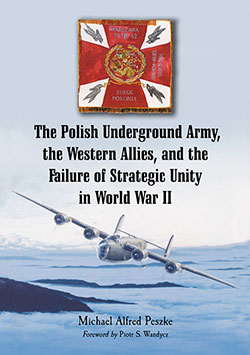The Polish Underground Army, the Western Allies, and the Failure of Strategic Unity in World War II
$35.00
In stock
About the Book
This military history covers the attempts of General Wladyslaw Sikorski and his successor (General Kazimierz Sosnkowski) to integrate Polish forces into Western strategy, and to have their clandestine forces declared an allied combatant. It addresses such topics as Poland’s part in the Norwegian and French campaigns, the Battle of Britain, Polish intelligence services, Polish radio communications, the Polish Parachute Brigade, the German invasion of the Soviet Union, the Bomber Offensive, the Katyn graves, Polish air crews in the RAF Transport Command, the Tehran Conference, Polish Wings in the 2nd Tactical Air Force, the Bardsea Plan, the invasion of Normandy, the Pierwsza Pancera, the Warsaw Uprising, Operation Freston, the disbanding of the Polish Home Army, and the Yalta Conference.
About the Author(s)
Bibliographic Details
Michael Alfred Peszke
Foreword by Piotr S. Wandycz
Format: softcover (7 x 10)
Pages: 254
Bibliographic Info: 15 photos, chronology, appendices, notes, bibliography, index
Copyright Date: 2009 [2005]
pISBN: 978-0-7864-4588-2
eISBN: 978-1-4766-1027-6
Imprint: McFarland
Table of Contents
Acknowledgments vii
Foreword 1
Preface 5
1. The Interwar Period, 1919–1939. 11
2. The Fight Continues: October 1939 through June 1940. 25
3. June 1940 through June 1941. 43
4. June 1941 through December 1942. 67
5. January 1943 through November 1943. 97
6. November 1943 through July 1944. 119
7. July 1944 through December 1944. 153
8. January 1945 through VE Day. 179
APPENDICES:
I. Agreement between the Government of the United Kingdom and the Polish Government Regarding Mutual Assistance (August 25, 1939) 185
II. First Polish-United Kingdom Agreement (1940) Pertaining to the Polish Air Force 188
III. Polish-British Land Forces Agreement (1940) 193
IV. Revised Polish-British Air Force Agreement (1944) 196
V. Costs of the Polish Forces While Based in the United Kingdom 202
VI. Strength of the Polish Forces in Exile at War’s End 204
VII. Military Symbolism: Occupied Homeland Sends Two Flags to Its Warriors in Exile 205
VIII. Chronology of Important Events 206
Chapter Notes 213
Bibliography 227
Index 241
Book Reviews & Awards
“ground-breaking new…scrupulously referenced…extensive bibliography…strikingly evocative”—The Polish Review; “excellent insight…ambitious, well written, and revealing…overwhelming”—Sarmatian Review; “a great deal of information and solid analysis…solid and worthwhile evaluation…offers the reader new insight into the relationship of Poland and its allies”—Military Review; “there’s much of interest to be found here…worth reading”—Stone & Stone Second World War Books.





